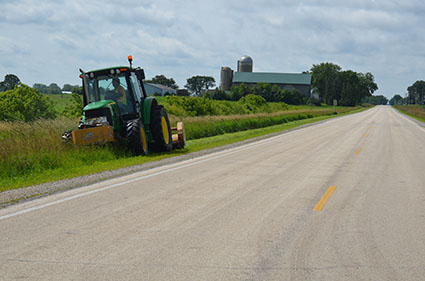Highway Maintenance |
Roadsides |
Mowing Wisconsin's roadsides |
Rural policy |
Urban policy
 Mowing is an effective, simple, and cost effective tool for maintaining safety and controlling unwanted vegetation within budget expectations. These are the key points of the rural mowing policy.
Mowing is an effective, simple, and cost effective tool for maintaining safety and controlling unwanted vegetation within budget expectations. These are the key points of the rural mowing policy.
Mowing completion dates map
HMM 07-05-35 Mowing Policy
- Safety mowing as necessary. This includes mowing “vision triangles” at intersections to provide motorists with clear lines of vision and enhance public safety.
- One long-line mowing along the state highway system per year, typically to a height of six inches, and 15 feet out from outside shoulders and five feet on inside shoulders (medians).
- Mowing must comply with
NR40. Mowing should be timed to be done before invasive species go to seed as identified in mowing completion dates map. This completion date varies based on the growing season across the state.
- If mowing happens after invasive species go to seed best management practices (BMP's) need to be followed. Comprehensive BMP's can be found in the “Invasive Species Best Management Practices: Rights of Way” document.
General WisDOT mowing guidelines for counties
- Mowing to control woody vegetation should only be done every three years, typically in conjunction with the annual long-line mowing.
- Mowing is not permitted in wet areas to prevent rutting and erosion.
- Mowing equipment is not permitted on steep slopes (3:1 or greater) due to scalping, rutting and operator safety concerns.
- Prior to mowing, remove all litter.
- Do not mow fence line to fence line.
- Mowing is allowed in newly seeded areas the first few years to keep weed competition down.
- Variations to the policy may occur in urban areas for consistency with mowing practices.
- An agreement can be developed between WisDOT and a local municipality allowing additional mowing at the municipality’s expense.